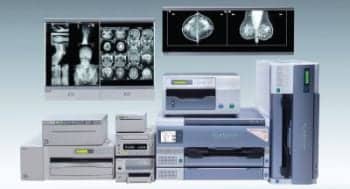
|
Ideas for Hospitals, Centers and Practices |
1,000th Installation of Siemens’ Digital Mammo System
Software Helps Imaging Departments Improve Efficiency
RIS Delivers “Double Whammy”
Federal Contract Opens the Door to Swissray
1,000th Installation of Siemens’ Digital Mammo System
When Susan B. Allen Memorial Hospital installed the MAMMOMAT NovationDR digital mammography system, it wasn’t just a big day for the 80-bed community hospital located in El Dorado, Kan. It also marked the occasion of the 1,000th installation of Siemens’ full-field digital mammography system, designed to handle a patient’s entire workup and optimize clinical workflow.

|
| With the recent installation of Siemens’ MAMMOMAT NovationDR, the radiology department at Susan B. Allen Memorial Hospital is now fully digital. |
David Shaw, vice president and chief operation officer at Susan B. Allen, explained the hospital’s decision to go digital, “Our ultimate goal is to offer screening, biopsy, and the pathology report in 3 days to patients in order to decrease patient anxiety. The addition of the MAMMOMAT NovationDR means that we can now offer a superior product and provide optimal patient comfort via features such as the flex paddle as well as dose savings.”
He further explained the hospital’s choice of Siemens’ product, citing its customer service and off-site training. “At Susan B. Allen, our motto is: ‘Great health care from people you trust.’ We’ve created a health care environment that combines a talented and compassionate staff with state-of-the-art technologies in order to provide the highest quality of patient care, so our decision to go with Siemens was a matter of trust and integrity—both qualities that we continuously experienced with their service branch. Their customer service representative was here day in and out during the entire installation. That was awesome.”
The MAMMOMAT NovationDR is designed to be a complete mammography system. The setup can handle the workup all the way from patient registration and image acquisition to post-processing and reading. Using syngo MammoReport, physicians can review images and prepare diagnostic reports while viewing images acquired by other modalities, such as MRI and ultrasound. Mammograms from third-party vendors can also be compared.
In addition, MAMMOMAT NovationDR can be integrated with virtually any storage management system independent of the manufacturer. MAMMOMAT NovationDR features a large-format detector size and Siemens’ exclusive dual anode technology with three distinct anode/filter combinations so that most women can be imaged quickly and efficiently regardless of breast size and density. The Opdose feature automatically selects the best anode/filter combination and the lowest dose for individual breast characteristics.
The system also includes features to enhance patient and user comfort including Opfocus, SoftSpeed, and Opcomp. These features maneuver the compression plate in such a way to include a large area of the pectoral muscle while keeping compression slow after initial contact and stopping compression at the optimal time while the breast is soft and pliable.
Regina Radtke, senior director, Women’s Health, Siemens’ Medical Solutions USA, highlighted the importance of continually advancing mammography technology, “With one in every eight women expected to be diagnosed with breast cancer at one point in her life, the good news is that advanced diagnostic and treatment technology developments have helped reduce death from breast cancer by approximately 24% since 1992. It continues to be our customers’ vision, as well as Siemens’ vision, to further improve this statistic, one woman at a time.”
—Ed Wilson
Software Helps Imaging Departments Improve Efficiency
In today’s economic climate, health care providers realize that owning great equipment is no more important than using the equipment efficiently. With that idea in mind, Philips Healthcare recently launched its Philips Utilization Services, designed to increase efficiency in imaging departments by reducing unproductive, idle time.

|
Andre van Est, product manager, professional services, Philips Healthcare, explained this motivation: “The current financial crisis forces all caregivers to carefully look at costs. There’s a greater recognition in the market that future success isn’t just about growth in revenues—it’s also about maximizing efficiencies and managing the bottom line. In many cases, the cost structures in imaging have remained static for a substantial amount of time. Utilization Services can help reduce internal costs without sacrificing while also potentially increasing the quality of patient care.”
Philips Utilization Services were developed by workflow experts following a thorough analysis of how exactly imaging technology is used in practice. The service looks for opportunities to increase efficiency every step of the way, from a preappointment reminder to patients to a patient changeover at the scanner itself. The idle time for scanners is tracked, as are time between scans and time spent at reception.
“By providing imaging departments with detailed usage information, we’re enabling them to become more time efficient, potentially resulting in better patient care and the ability to serve more patients with the same resources,” said Michiel Manuel, senior vice president and general manager for customer service, Global Sales & Service International, Philips Healthcare. “The data can be particularly valuable when deciding how and when to upgrade or transition to a new system.”
Utilization Services are currently available for CT and MR machines manufactured by Philips and provide detailed, yet easy-to-interpret daily usage reports. A “Companion Guide” is used to help explain the reports, offering suggestions as to how efficiency can be improved based on the report data.
van Est described how any imaging department can benefit from this service, regardless of the size or type of facility: “For private practices based in the United States, [Utilization Services] can help to mitigate the potentially negative impact of the Deficit Reduction Act, and more broadly, it can help to create new revenue streams and save costs. It can also help boost overall quality, potentially leading to improved reputation and ultimately a better competitive position.
“Community and larger hospitals can benefit from streamlined processes because it will help them to reduce costs or do more with the same staff and time. It will also bring the discussion in the department management team to a new level, where decisions can be based on facts and no longer on gut feeling or intuition,” said van Est.
—E. Wilson
RIS Delivers “Double Whammy”
Today’s complicated reimbursement picture and razor-thin margins mean that capturing every dollar is crucial to survival. Zotec Partners has developed a RIS that is built to get the maximum reimbursement at an affordable rate. According to T. Scott Law, president and CEO of Zotec Partners, the measure of success is a 10% to 15% increase in revenue recovery with a 20% to 50% decrease in costs, which he describes as a “double whammy.”

|
The company backs its statistics with its pricing structure—the RIS system has an initial start-up cost with a monthly fee based on the size of the practice. If Zotec handles the billing, there’s an additional percentage markup to cover its costs. The Indianapolis-based company’s system is compatible with Microsoft SQL platforms.
Part of the company’s success in recovery comes from the fact that it specializes in radiology. “We like to go deep into specialties. We’re experts at solving the problems facing radiologists,” Law said. And the statistics bear him out. Since Zotec began focusing primarily on radiology about 7 years ago, it has handled 40 million transactions.
Zotec offers a powerful decision support system (DSS) that allows radiology departments to monitor that their insurance carriers are handling their contracts correctly. This is significant for most radiology services, which can see as many as 30% of their claims inappropriately denied. So a way to make sure that insurers are living up to their end of the agreement is critical in making a radiology service profitable.
The EBC Decision Support module, which is part of the Zotec RIS package, allows contract administrators to data mine, drill down, chart, and analyze data in a robust, meaningful way. The EBC Decision Support includes analysis cubes, representing best practices for viewing and digesting information. The reporting module also includes a wizard that allows for the creation of individualized analysis “cubes.” Among the things that radiology departments can do is effectively monitor the amount of reimbursement among providers, making sure that they are being remunerated correctly.
The DSS also supports budget management, the revenue cycle, cash flow, and payor analysis. According to the company, by consolidating these functions, reporting time is cut in half.
Practices can also data mine other areas of the practice with the DSS module, such as performance, including financial and productivity patterns at individual centers, referral patterns and trends, and the individual productivity of physicians, transcriptionists, schedulers, and all back-office support and billing personnel. With this function, performance, and particularly underperformance warning signs, can be quickly assessed and addressed.
—C.A. Wolski
Federal Contract Opens the Door to Swissray
Swissray International, East Brunswick, NJ, has been awarded a new contract by the Department of Veterans Affairs. The contract will allow any government agency—including the Department of Defense and VA Medical Centers—to purchase digital radiography systems from Swissray.

|
According to John Monahan, senior vice president of strategic accounts, what sold the government on the company was the systems’ excellent workflow and quality. Swissray guarantees 99% uptime on all of its systems. In addition, its digital radiography systems have a low dose radiation yield.
Aiding the throughput efficiency is the Automated Positioning System (APS). With a handheld device, a technician can automatically set the scanner in one of 1,296 preprogrammed positions. Once a scan is completed, the image will appear on a SwissVision workstation within 7 seconds.
The workstation comes with numerous functions that allow the user to work with the image in various ways. The functions include windowing, leveling, zoom, and rotation. The CutOff and SizeWise functions reduce image file size, optimizing data storage capacity. All patient data is stored in the DICOM header, which can be retrieved for future examinations.
The SwissVision also includes a variety of automated quality control features, including a statistical tool to perform repeat and reject digital examination analysis, and an exposure index to monitor image quality as it relates to radiation dose.
The APS includes a memory function, which is particularly useful for follow-up examinations. With a single keystroke of the remote control, the detector is repositioned and collimated, the exposure factors are set, and acquisition is prepared using parameters retrieved from the DICOM header of the previous exam. Every Swissray DR system is equipped with the APS function.
Swissray systems come in a variety of specialized packages, including pediatrics, orthopedics, bone mineral testing, and chest imaging.
The current government contract took 2 months of preparation work, according to Monahan, and about a year to get final approval. The supporting documentation included a business and technical proposal. With exercisable option years, the contract could be effective until December 2016.
The current contract builds on the company’s long and successful track record with the government. Previously, it had a contract with the Defense Supply Center of Philadelphia and has installed digital radiography systems in several Veterans Administration Hospitals and military base hospitals over the past 9 years. Under the current contract, which came in force in December 2008, Swissray has already begun deploying DR solutions in several Department of Veterans Affairs facilities.
—C.A. Wolski





